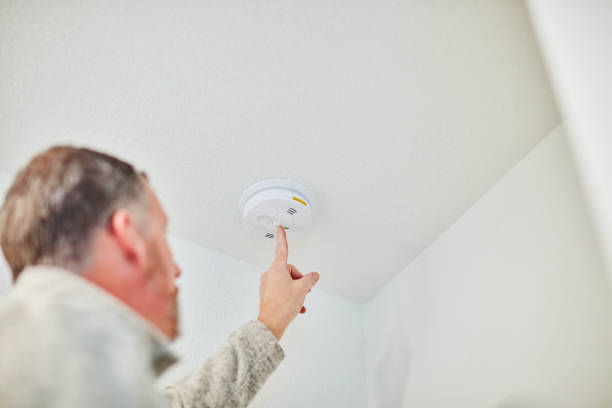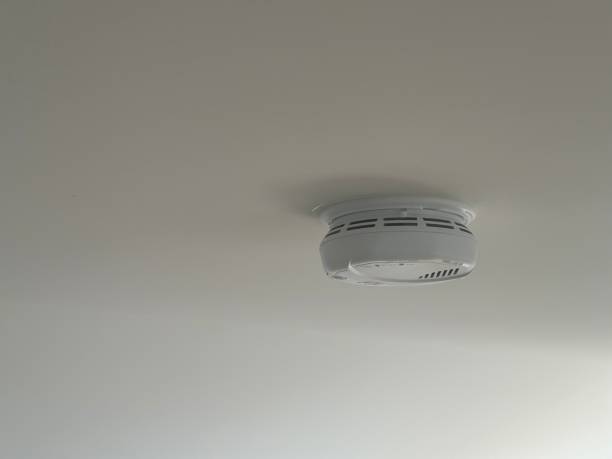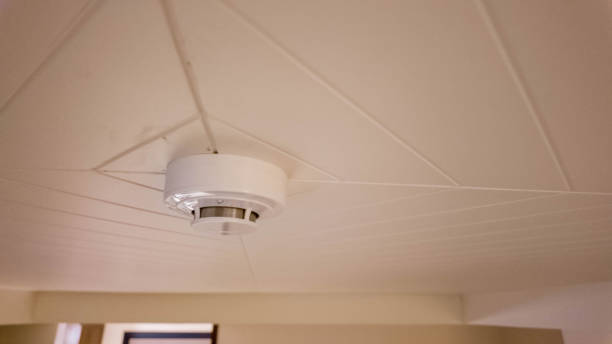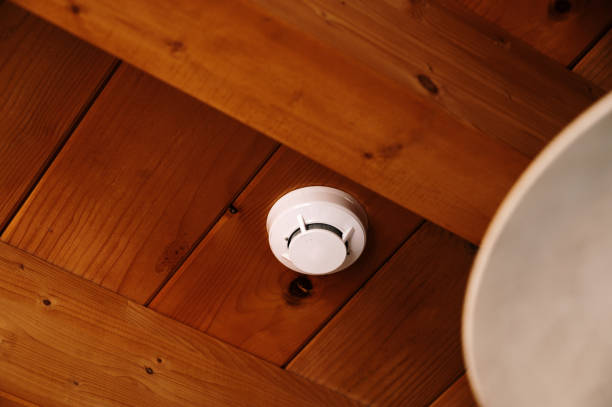That relentless, high-pitched chirp… If you’re hearing that sound echoing from your ceiling, chances are you’re dealing with a first alert smoke detector beeping. It’s a noise that can quickly go from a minor nuisance to seriously disruptive. While First Alert is a trusted name in keeping our homes safe, their smoke alarms sometimes communicate in ways that cause confusion and frustration – namely, that incessant beeping!
But here’s the crucial thing: a first alert smoke detector beeping isn’t just random noise. It’s a signal, the device’s way of telling you something needs attention. It could be a simple fix like a battery change, a sign it needs cleaning, or even a critical warning that the detector itself is too old to function reliably. Ignoring this first alert smoke detector beeping is never the right move, as it could mean your first line of defense against fire isn’t working correctly.
Don’t worry, we’re here to help you decode those chirps. This guide will walk you through the most common reasons behind a first alert smoke detector beeping, provide clear, step-by-step instructions to silence it, and offer practical tips to prevent it from happening again. From simple battery swaps to understanding end-of-life signals and dealing with hardwired units, let’s get that beeping stopped and restore peace (and safety!) to your home.
Why is My First Alert Smoke Detector Beeping? Decoding the Signals

That first alert smoke detector beeping isn’t trying to annoy you (usually!). It’s using a specific language of chirps to communicate different needs or problems. Let’s break down the most common culprits:
1. Low Battery: The Usual Suspect
- The Sound: Typically, one sharp “chirp” every 30 to 60 seconds. This is, by far, the most frequent reason for a first alert smoke detector beeping.
- Why it Happens: All smoke detectors need power. Battery-only models run entirely on them, while hardwired models use batteries as essential backup for power outages. When the battery’s power level dips too low, the detector chirps insistently, reminding you it’s time for a change. Many people with hardwired units forget about this backup battery, leading to surprise when the first alert smoke detector beeping starts.
- The Fix: Swap out the battery immediately. Use a brand new one of the type recommended by First Alert for your specific model (usually 9V or AA alkaline – check the label or manual). First Alert often suggests reliable brands like Duracell or Energizer ^55. Don’t use rechargeable batteries unless the manual explicitly says it’s okay, as they often don’t work correctly in smoke detectors.
2. End-of-Life (EOL) Signal: Time for a New Detector
- The Sound: This is usually a more complex pattern – often 3 or 5 chirps repeating every 30-60 seconds, sometimes with a flashing light. The exact pattern can vary, so checking your specific model’s manual is key. This distinct first alert smoke detector beeping pattern means the entire unit has expired.
- Why it Happens: Smoke detectors have a limited lifespan. Most standard smoke alarms need replacing every 10 years; combination smoke/CO alarms might need replacement sooner (often 7-10 years). Over time, the internal sensors degrade and become less reliable at detecting smoke or carbon monoxide. This EOL chirp is a required safety feature designed to warn you that the entire detector needs replacing, not just the battery. As some users have noted ^5, sometimes detectors fail earlier than expected, but reaching the 7-10 year mark is the intended trigger for this specific first alert smoke detector beeping.
- The Fix: Replace the whole smoke detector unit. Look for the manufacture date or “Replace By” date printed on the device. Putting in a new battery will not stop the end-of-life signal.
3. Malfunction or Error Code
- The Sound: Irregular chirping, odd patterns not matching low battery or EOL signals (like the baffling intermittent triple chirp mentioned by a user online ^5, which manuals might link to wiring issues, but could also signal a faulty unit if wiring is confirmed okay). A first alert smoke detector beeping erratically often signals an internal fault.
- Why it Happens: The detector could have an internal problem, the sensor might have failed prematurely, or there could be communication issues in an interconnected hardwired system. Sometimes, leftover power after a battery change can cause temporary strange behavior [^15, ^60]. Power surges or brownouts might also trigger fault modes in hardwired alarms.
- The Fix: Try performing a full reset (see troubleshooting steps below). For hardwired systems, check the wiring connections (after turning off power). If the odd first alert smoke detector beeping continues after resetting and cleaning, the unit itself is likely faulty and needs to be replaced. You can often find specific error code meanings by searching your model number on the First Alert Support site.
4. Pesky Environmental Factors: Dust, Humidity & Temperature Swings
- The Sound: Occasional, seemingly random chirps, or sometimes even false alarms followed by a period of chirping. This type of first alert smoke detector beeping can be tricky to pin down.
- Why it Happens:
- Dust & Critters: Dust, cobwebs, or even tiny insects can get inside the sensing chamber, interfering with the sensor and causing chirps or false alarms.
- Temperature Extremes: Placing detectors near heating/cooling vents, drafty windows, fireplaces, or in unconditioned spaces like garages or attics can expose them to rapid temperature shifts or temperatures outside their ideal range (usually 40-100°F or 4-38°C). This stress can cause malfunctions and chirping.
- Humidity & Steam: High humidity, especially from showers or cooking without good ventilation, can cause condensation inside the detector, leading to temporary first alert smoke detector beeping or false alarms.
- The Fix: Clean the detector regularly (more on this below!). Make sure detectors aren’t installed too close to sources of steam, drafts, or extreme heat/cold. Consider relocating the detector if its location seems suspect, always following the installation guidelines provided by First Alert and the National Fire Protection Association (NFPA) for safe and effective placement.
5. Accidental “Hush” Button Press
- The Sound: A single chirp roughly every minute, lasting for about 15 minutes ^2. This specific first alert smoke detector beeping pattern usually means the silence feature is active.
- Why it Happens: Most smoke detectors have a “Silence” or “Hush” button to temporarily quiet nuisance alarms (like when you slightly burn toast). If this button gets pressed by mistake, or if it’s used to temporarily silence a low battery chirp, the detector might chirp periodically during this silenced phase.
- The Fix: Usually, just wait it out (around 15 minutes). If it was silencing a low battery warning, the regular low-battery chirp (one beep every 30-60 seconds) will likely resume, reminding you to change the battery.
6. Wiring Woes (Hardwired Models Only)
- The Sound: Intermittent chirps, possibly the specific error code mentioned in your manual (like that triple chirp ^5), or problems when testing the interconnected system. This type of first alert smoke detector beeping is exclusive to alarms connected to your home’s AC power.
- Why it Happens:
- Loose Wires: The connections linking the detector to the house power (black – hot, white – neutral) or the interconnect wire (often orange or red/yellow) might be loose within the wire nuts or where the harness plugs into the alarm.
- Wiring Mix-up: If alarms were recently installed or replaced, the wires might have been connected incorrectly.
- Power Hiccups: Brief power outages, surges, or flickers can sometimes cause temporary chirping as the alarm switches between AC power and battery backup.
- Interference: Less commonly, electrical “noise” on the power lines or strong radio frequency interference could potentially affect interconnected systems.
- The Fix: SAFETY FIRST! Always turn off the power circuit dedicated to your smoke detectors at your home’s breaker box before touching any wires. Carefully check that the wiring harness is securely plugged into the detector. Check the wire nut connections in the ceiling electrical box – ensure they are tight and wires are properly matched (black-to-black, white-to-white, orange-to-orange). If you see loose wires, damaged insulation, scorch marks, or feel unsure about dealing with electrical wiring, STOP and call a certified electrician. Faulty wiring is a fire risk, and persistent first alert smoke detector beeping in hardwired systems sometimes points to subtle issues needing professional eyes. For detailed wiring troubleshooting, reliable guides like the BRK/First Alert Troubleshooting Guide can be helpful.
7. Bad Location, Bad Vibes (Placement Issues)
- The Sound: Frequent false alarms that trigger the main siren, often followed by chirping, or intermittent chirps linked to environmental triggers. Poor placement is a common cause of frustrating first alert smoke detector beeping.
- Why it Happens: Installing detectors too close to kitchens (cooking fumes, even minor ones), bathrooms (steam), heating/cooling vents (drafts carrying dust), ceiling fans (more drafts), or even certain types of fluorescent lights (potential electrical interference) can lead to problems.
- The Fix: Review the placement. Ensure detectors are installed according to First Alert and NFPA guidelines. Key distances include: generally at least 10 feet from cooking appliances, 3 feet from bathroom doors (that contain a tub/shower) and HVAC vents, and away from “dead air” corners where walls meet ceilings.
Your Step-by-Step Guide to Silencing First Alert Smoke Detector Beeping

Alright, let’s tackle that annoying first alert smoke detector beeping head-on. Follow these steps systematically:
CRITICAL SAFETY REMINDER: If your smoke detector is sounding a loud, continuous, non-stop alarm (not the intermittent chirping we’re discussing), treat it as a real emergency. Get everyone out of the house immediately, then call 911 from a safe location outside. Only troubleshoot chirping sounds once you are certain there is no actual fire or carbon monoxide emergency.
Step 1: Pinpoint the Noisy Offender
- In homes with multiple interconnected detectors, finding the exact unit causing the first alert smoke detector beeping can be tricky. Often, the chirping unit will have an LED light that flashes in sync with the sound.
- Walk to each detector and listen closely. Be patient – it might take a minute or two for the chirp cycle to repeat. First Alert offers tips on finding the chirping unit.
- Some newer First Alert systems might have features that announce the location of the problem – check your manual.
Step 2: Battery Check & Replacement (The Go-To Fix!)
- This solves the most common issue: the single chirp every 30-60 seconds indicating a low battery.
- For Battery-Only Alarms: Open the battery compartment (this might involve sliding a door, swinging it open, or twisting the unit off its base). Pop out the old battery.
- For Hardwired Alarms: Remember, these have a backup battery. Find the battery door (often on the side, or you might need to gently twist the alarm off its ceiling mount). Replace that battery.
- Use the Right Battery: Always use a fresh, new battery of the type specified in your First Alert manual (e.g., 9V alkaline, AA alkaline). Stick to recommended brands like Duracell or Energizer for best results ^55. Avoid cheap off-brands or rechargeables unless explicitly approved.
- Install Correctly: Pay attention to the positive (+) and negative (-) terminals – put the battery in the right way!
- Test it! After the new battery is in, press and hold the test button for about 15-30 seconds ^15. This does a few things: it helps reset the alarm, clears any leftover charge, and confirms the new battery works. The alarm should sound loudly during the test. If your alarms are interconnected, all of them should sound when you test one. If it chirps immediately after putting in a new battery, try the reset procedure mentioned in Step 4 again ^60.
Step 3: Clean Your Smoke Detector Thoroughly
- Dust bunnies and grime are sneaky culprits behind erratic first alert smoke detector beeping and annoying false alarms. Regular cleaning is essential maintenance [^16].
- Safety Power Down (Hardwired): If your detector is hardwired, switch off the power to that circuit at your breaker box first.
- Remove Gently: Carefully twist the detector counter-clockwise (usually) to remove it from its mounting bracket.
- Vacuum Power: Use the soft brush attachment on your vacuum cleaner. Gently vacuum all around the vents and openings on the detector cover. Get into those little slots.
- Canned Air (Optional, Use Carefully): You can cautiously use compressed air designed for electronics to dislodge deeper dust. Keep the can upright and spray in short bursts from several inches away, following the instructions on the can. Never spray household cleaners or solvents onto or into the detector.
- Wipe Down: Use a clean, dry microfiber cloth (or one very slightly dampened with water) to wipe the outside cover.
- Reinstall & Test: Put the detector back onto its base (turn clockwise to lock), restore power if you turned it off, and press the test button again to make sure it’s happy and working.
Step 4: Perform a Full Reset
- Sometimes, electronic devices just need a reboot to clear temporary glitches causing that first alert smoke detector beeping.
- For Battery-Only Models:
- Remove the battery.
- Press and hold the test button for 15-30 seconds. This drains any residual electrical charge.
- Put the battery back in (make sure it’s fresh!).
- Press the test button again to confirm it works.
- For Hardwired Models:
- Turn off the power at the circuit breaker.
- Carefully remove the detector from its mounting bracket.
- Unplug the power connector harness from the back of the detector.
- Remove the backup battery.
- Press and hold the test button for 15-30 seconds to completely discharge the unit.
- Install a fresh backup battery.
- Plug the power connector harness back in securely.
- Reattach the detector to its mounting bracket.
- Turn the power back on at the circuit breaker.
- The detector might flash or beep briefly as it powers up – this is normal. Finally, press the test button to ensure everything is functioning correctly.
Step 5: Investigate Environmental Triggers
- Think about where the first alert smoke detector beeping unit is located. Is it too close to the bathroom, kitchen stove, a heating/cooling vent, or in a spot known for temperature swings (like an uninsulated attic or garage)?
- Could recent activities be the cause? Things like heavy cooking generating smoke or steam, very steamy showers without an exhaust fan, running a humidifier nearby, painting fumes, or dust from recent renovations can all temporarily trigger chirps or alarms.
- Try improving ventilation in steamy areas (use those kitchen and bathroom exhaust fans!).
- If the location seems fundamentally problematic, consider moving the detector. But always ensure you follow safe placement guidelines from First Alert and the NFPA to maintain proper fire detection coverage in your home.
Step 6: Inspect Wiring (Hardwired Models ONLY – Use Extreme Caution!)
- REPEAT: TURN OFF POWER AT THE BREAKER BOX FIRST. Never work on live wires.
- Carefully take the detector down from its base.
- Check the connection where the wiring harness plugs into the detector. Is it pushed in all the way and clicked securely?
- Look inside the electrical box in the ceiling. Gently tug on the wires connected by wire nuts. Are they all tight? Are any wire strands loose or exposed? Is the insulation intact?
- Double-check the wire colors match up correctly: black (hot) to black, white (neutral) to white, and the interconnect wire (usually orange, sometimes red or yellow) to the same color interconnect wire on other alarms.
- If you find any loose connections, damaged wires, signs of overheating (scorch marks), or if you are at all uncomfortable or unsure about electrical work, STOP immediately and call a qualified electrician. Messing up wiring is dangerous. That persistent intermittent first alert smoke detector beeping ^5 sometimes signals a subtle wiring issue best left to a pro.
Step 7: Consult Your Specific First Alert Manual
- First Alert makes many different models, and the exact beep codes or features can vary. Your user manual is the definitive guide for your specific detector.
- Find the troubleshooting section. It should list what different chirp patterns (e.g., 1 chirp vs. 3 chirps vs. 5 chirps) and LED light flashes mean for that model (like the SC9120B [^16, ^57], 9120B [^26], 7020BSL [^49], etc.).
- Lost the paper manual? No problem. You can usually find it online by searching for your model number on the First Alert website or their extensive Support Portal.
Step 8: Check the Detector’s Age / Expiration Date
- If you’ve tried everything above and the first alert smoke detector beeping just won’t quit, especially if it’s making that multi-chirp EOL pattern, it’s time to check its age.
- Look carefully on the back or side of the detector housing. There should be a sticker with a “Replace By” date or a “Date of Manufacture”.
- Smoke-only alarms typically last 10 years from the date of manufacture. Combination smoke/CO alarms might be 7 or 10 years ^53. If your detector is past its expiration date, or if it’s giving the confirmed EOL chirp signal, it must be replaced. No amount of cleaning or battery changes will fix an expired sensor.
Step 9: Rule Out Interference (Interconnected Systems)
- This is less common, but sometimes electrical noise from appliances on the same circuit, or strong radio signals, can interfere with the communication between interconnected hardwired alarms, causing odd behavior or first alert smoke detector beeping.
- Diagnosing this is tricky. Try the full reset procedure (Step 4) on every single interconnected alarm in your system. Also, make sure you haven’t accidentally mixed incompatible alarm models or brands on the same interconnected circuit – always use compatible First Alert/BRK units together.
- If you strongly suspect interference is the issue after exhausting other possibilities, consulting an electrician might be needed to investigate your home’s wiring.
Understanding Common First Alert Beeping Patterns Summarized

Let’s quickly recap the most common sounds your first alert smoke detector might make:
- One Chirp every 30-60 seconds: 99% chance it’s a Low Battery. Replace it!
- Three or Five Chirps every 30-60 seconds: Usually the End-of-Life (EOL) signal. Replace the entire detector unit.
- One Chirp per minute for about 15 minutes: Probably the Hush/Silence Mode is active ^2. Wait for it to finish, then address the original cause if needed (like changing the battery if the low battery chirp resumes).
- Intermittent Triple Chirp (Hardwired): Manuals often point to a Wiring Fault ^5. However, if wiring looks perfect and resets don’t help, user experiences suggest it can also indicate a Malfunctioning Unit needing replacement.
- Chirping Right After New Battery: Try the reset trick again: Press and hold the test button for 15-30 seconds after the new battery is in, to clear any residual charge [^15, ^60].
Always remember: your specific model’s manual (often found on the First Alert Support site by searching your model number like 9120B ^48 or SC9120B ^56) is the ultimate authority on its unique sounds and signals.
Keeping the Peace: Preventing Future First Alert Smoke Detector Beeping
Wouldn’t it be nice to avoid that first alert smoke detector beeping altogether? Regular maintenance is key:
- Proactive Battery Changes: Don’t wait for the low battery chirp! Replace batteries in all your detectors at least once a year. Pick an easy-to-remember date, like when you change your clocks for Daylight Saving Time. Use high-quality alkaline batteries dated well into the future. For those newer alarms with 10-year sealed batteries, you replace the whole unit when it starts its end-of-life chirp. Find official battery replacement guidance here [^55, ^64].
- Monthly Testing is a Must: Push the test button on every smoke alarm in your house once a month. This confirms the electronics, siren, and power source (battery or AC) are working. For interconnected systems, testing one should make all of them sound the alarm.
- Clean Regularly: Gently vacuum your smoke detectors every month or two, and give them a more thorough cleaning (as described in Step 3) at least twice a year [^16]. This simple step prevents dust buildup – a major cause of nuisance first alert smoke detector beeping and false alarms.
- Know Your Expiration Dates: When you install new detectors, write the installation date or the calculated replacement date (10 years from manufacture, usually) on the unit itself with a marker, or set a digital calendar reminder. Plan and budget for replacements before they start chirping their EOL signal.
- Smart Placement Matters: Double-check that your detectors are installed in optimal locations, away from common interference sources like cooking fumes, shower steam, drafts from vents, and dusty areas, following recommendations from First Alert and safety organizations like the NFPA.
- Compatibility is Key (Interconnected): If you have hardwired alarms linked together, always replace units with compatible models from the same manufacturer (First Alert / BRK). Mixing brands or incompatible models can lead to system failures and unpredictable behavior, including unwanted first alert smoke detector beeping.
When DIY Isn’t Enough: Knowing When to Call for Help
Most first alert smoke detector beeping issues are fixable with the steps above. But sometimes, you need to bring in backup:
- The Chirp That Won’t Quit: If you’ve diligently replaced the battery, thoroughly cleaned the unit, performed a full reset, confirmed it’s not expired, and it still keeps chirping – the detector itself is almost certainly faulty and needs to be replaced entirely.
- Hardwired System Headaches: If you suspect wiring problems (loose connections, incorrect wiring you can’t fix), see any scorch marks around the detector or wiring, or simply don’t feel comfortable working with your home’s electrical system, call a qualified electrician. Don’t take risks with wiring.
- Mysterious Beep Codes: If you’re hearing a beep pattern you absolutely can’t identify using the manual or online resources like the First Alert Support site, contacting their customer service directly might provide the answer.
- Frequent False Alarms: If a particular detector repeatedly sounds the full alarm for no apparent reason, even after thorough cleaning and ensuring it’s well-placed, it might be overly sensitive or faulty. Replacing it is the safest bet.
Conclusion: Silence the Chirp, Prioritize Your Safety
That first alert smoke detector beeping, while annoying, serves a vital purpose. It’s your safety device communicating a need. Whether it’s a simple request for a fresh battery, a nudge for cleaning, a warning about a malfunction, or the critical end-of-life notification telling you it’s time for retirement, taking action promptly is crucial. Ignoring the beeps means potentially compromising your family’s safety.
By methodically following the troubleshooting steps – identifying the source, checking batteries, cleaning, resetting, verifying placement, inspecting wiring safely (if applicable), and checking the unit’s age – you can likely resolve most first alert smoke detector beeping issues yourself. Remember that consistent maintenance, including yearly battery changes and regular cleaning, is your best defense against future disruptions.
Most importantly, never disable a smoke detector because it’s chirping. Address the cause. Replace units before they expire. A working smoke detector is one of the most important safety devices in your home. For more insights into smoke alarm sounds and best practices, you can explore resources like smokedetectorbeeping.com or consult the fire safety experts at the National Fire Protection Association (NFPA). Stay safe, and enjoy the silence (the good kind!) in your home.
Disclaimer: Always prioritize safety. If you suspect a fire or CO emergency, evacuate immediately and call 911. If you are uncomfortable with any troubleshooting steps, especially those involving electrical wiring, contact a qualified professional.
Selected References & Resources:
[^16]: BRK SC9120B Manual via Rackcdn (Example Manual – Maintenance/Troubleshooting)
[^26]: First Alert 9120B Manual via FirstAlertStore (Example Model Manual)
[^32]: BRK/First Alert Troubleshooting Guide via BRK Electronics (General Troubleshooting)
[^49]: First Alert 7020BSL Manual via FirstAlertStore (Example Model Manual)


发表回复